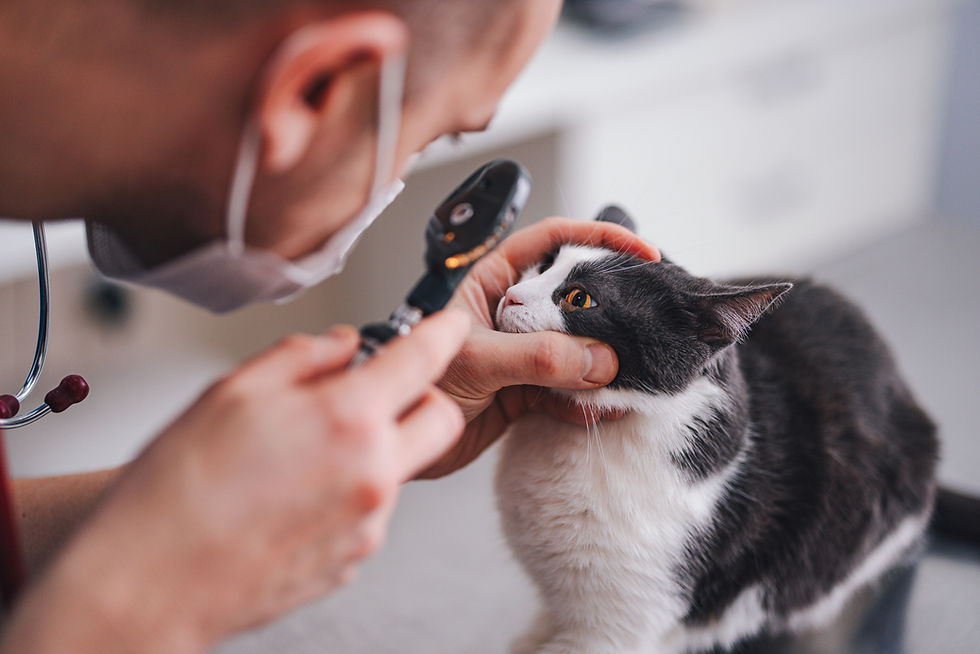MCV FAQ: What is toxoplasmosis and can I catch it from my cat?
- Carolyn O'Brien
- Aug 22, 2024
- 3 min read
Updated: Aug 23, 2024
Toxoplasmosis is a widespread infection caused by the parasite Toxoplasma gondii, affecting both humans and animals around the globe. While cats are the definitive hosts of this parasite, meaning the parasite completes its life cycle in them, it's important to understand the implications for both feline and human health. Despite its prevalence, many cats with toxoplasmosis show no symptoms, but the infection can pose significant risks, especially to certain vulnerable groups.
What is Toxoplasmosis?
Toxoplasma gondii is a microscopic parasite that can infect a wide range of warm-blooded animals, including humans. In cats, the parasite can reproduce sexually, leading to the shedding of oocysts (a form of the parasite) in their faeces. Once shed, these oocysts take about 1-5 days to become infectious. However, most infected cats remain asymptomatic, meaning they show no signs of illness, making it difficult to detect the infection.
How is Toxoplasmosis Transmitted?
Cats typically become infected with T. gondii by consuming prey, such as rodents or birds, that harbour the parasite. Once infected, cats can begin shedding oocysts in their faeces within a few days, and this shedding can last up to two weeks. These oocysts are extremely hardy and can survive in the environment for years, posing a risk to other animals and humans.

In the image above: the lifecycle is as follows: a. Ingestion of prey containing tissue cysts. b. The cyst wall is digested in the stomach and intestines, liberating bradyzoites. c. Bradyzoites invade epitelial cells of the intestine. d. In the enterocytes bradyzoites divide by schizogony giving rise to merozoites. e. Merozoites differentiate into microgamonts, or macrogametes (f). g Fertilization gives rise to an unsporulated oocyst excreted with cat feces (h). i Sporulation occurs and generates two sporocysts with four sporozoites each (j).
Humans can become infected with T. gondii in several ways, most commonly through:
Ingesting undercooked meat containing tissue cysts of the parasite.
Consuming food or water contaminated with oocysts from cat faeces.
Handling soil or exposure to sandpits contaminated with cat faeces, especially without proper handwashing.
Congenital transmission from a pregnant woman to her unborn child if she becomes infected during pregnancy.
Receiving an infected blood transfusion or transplant organ
Symptoms in Cats and Humans
In cats, toxoplasmosis is often asymptomatic, but when symptoms do occur, they may include fever, loss of appetite, and lethargy. In severe cases, especially in kittens or immunocompromised cats, the infection can lead to more serious issues like pneumonia, neurological symptoms, and even death. Humans infected with T. gondii are usually asymptomatic as well. However, the infection can cause flu-like symptoms such as swollen lymph nodes and muscle aches. For immunocompromised individuals and pregnant women, the infection can be much more serious, leading to complications such as neurological damage or congenital toxoplasmosis in newborns, which can result in vision impairment or other long-term health problems.
Diagnosing and Treating Toxoplasmosis
Diagnosing toxoplasmosis in cats can be challenging. Routine testing for T. gondii in healthy cats is not recommended since a positive antibody test does not necessarily mean the cat is currently shedding the parasite. Instead, diagnosis often relies on a combination of clinical signs, serologic tests, and sometimes imaging or biopsy if organs are affected. There is no specific licensed treatment for feline toxoplasmosis, but antibiotics like clindamycin are commonly used to manage the infection. The prognosis for cats with toxoplasmosis varies, depending on the organs affected and how quickly treatment is initiated.
Reducing the Risk of Toxoplasmosis
For cat owners and others at risk, there are several strategies to reduce the risk of toxoplasmosis:
Daily litter box cleaning is crucial since oocysts need at least 24 hours after shedding to become infectious.
Keeping cats indoors and feeding commercial food rather than allowing them to hunt can prevent them from ingesting the parasite.
Washing hands thoroughly after handling raw meat, gardening, or cleaning litter boxes can prevent accidental ingestion of the parasite.
Cooking meat thoroughly and washing or peeling fruits and vegetables can help reduce the risk of ingesting the parasite from contaminated food.
Contrary to popular belief, direct contact with cats is not a significant risk factor for human infection. However, taking these simple precautions can significantly reduce the risk of transmission.

Conclusion
Toxoplasmosis is a common but often silent infection in cats, with most showing no signs of illness. While the risks to human health, particularly for pregnant women and those with weakened immune systems, are real, they can be effectively managed with good hygiene and responsible pet care. By keeping cats indoors, cleaning litter boxes daily, and following proper food safety practices, cat owners can enjoy their feline companions while minimising the risk of toxoplasmosis.



